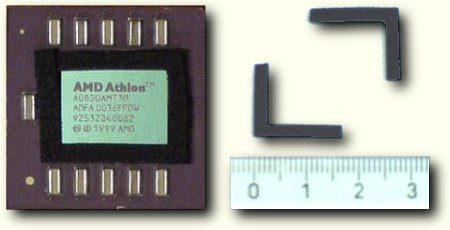Processors On The Rocks VOL. 2
Features
By
Thomas Pabst
published
Good Things
Let's look at the positive sides of Vapochill first:
- Thermic Acceleration
This is obviously the very reason why people would buy Vapochill and it is clearly its main benefit. Right now it provides almost 25% acceleration to the fastest AMD processor and it will soon accelerate Intel's Pentium 4 processor as well.- Very Low Noise
Vapochill is quieter than any normal PC unless it should be particularly noise reduced. The compressor is almost inaudible and the fan in front of the condenser is a quiet and high quality Papst-fan as well. Even the optional Papst-fan for the front of the case adds only very little noise.- VersatilityM
It is certainly a big plus for Vapochill that you can use it on a wide variety of motherboards and processors. However, providing a universal product bears a lot of risks too.- Weight
Vapochill is no light weight, but its 20 kg / 44.5 lbs are nothing in comparison to Kryotech's monsters. As long as you are of average strength you should be well capable of carrying Vapochill around and e.g. bring it to LAN-parties.
Problems
There's always a dark side and Vapochill has got a few problems too.
- Mounting - Details
- Evaporator not sitting properly
It happened to me quite often that I would fire up Vapochill and then be unable to reach any reasonable 'acceleration'-results. This is often due to a badly aligned evaporator. Unfortunately it is impossible to see if the copper-piece sits properly centered on the CPU-die. I found out that removing the evaporator kit and putting it back on more carefully would solve the problem. However, each removal/installation procedure of the evaporator bears the high risk of damaging the processor-die.Risk of destroying the CPU
It is a very serious problem that Vapochill can easily damage the edges of the processor die especially of Athlon and Duron processors. I had a whole lot of discussions about this issue with Asetek and we came up with several solutions that should make this touchy mounting process a whole lot easier. One of the ideas to save the die is this one:
Those little pieces of plastic or (as in this case) insulation material can save the CPU-die. Vapochill is currently experimenting with them and will hopefully include them soon.
- Evaporator falling off
In a worst case scenario you are taking the risk of the evaporator falling off the CPU if the brackets don't sit well enough or if you over-tightened the screws and the notches break off the socket. In this case an Athlon/Duron processor would die instantly. Asetek is now putting those little spacers between the retention clip and the brackets, to make sure that the screws don't get over-tightened.
- PSU Problems With Sensitive Motherboards
It happened to me that the MSI MS-6341 motherboard would not boot properly, because each time the compressor came on (a few seconds after you start Vapochill) the board would shut down. I managed to run the board in Vapochill by disconnecting the RESET-connector that comes from the ChillControl. As soon as the compressor had started I was able to reconnect the RESET-plug and the system booted normally. The reason behind this strange behavior turned out to be the power supply. It was unable to keep the voltage steady enough when the compressor started and the MSI-board seems to be very sensitive to little voltage spikes in the RESET-line.- The Hose To The Evaporator Is Too Short For Some Boards
In some cases the processor-socket is so far away from the refrigeration unit that the hose to the evaporator kit is not long enough to reach the processor. In this case you cannot use Vapochill, at least as long as you leave everything in the case. Asetek pointed out to me that they do not say that they support every motherboard, but a large variety of motherboards. It is definitely wise to be aware of the hose-length issue before choosing the wrong motherboard for Vapochill. Vapochill's website supplies a list of supported motherboards.
I discussed this issue with Andre and he suggested to offer two different hose sizes. We have to realize that it is no solution to simply supply a longer hose. If the hose is too long it gets bent and pushed against the housing, which compromises its insulation and thus bears the risk of condensation.
Stay On the Cutting Edge: Get the Tom's Hardware Newsletter
Get Tom's Hardware's best news and in-depth reviews, straight to your inbox.
No comments yet
Comment from the forums
